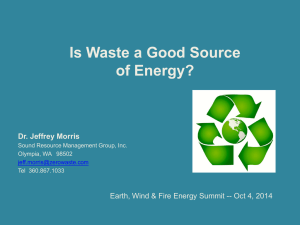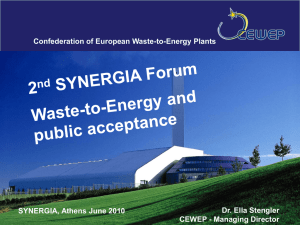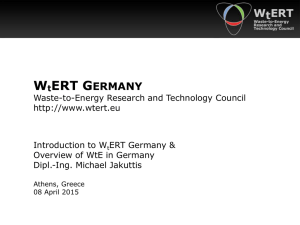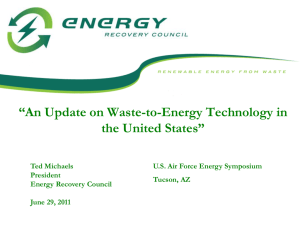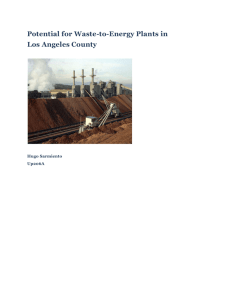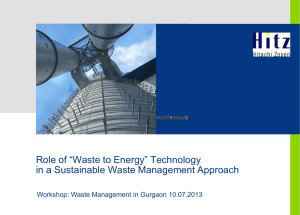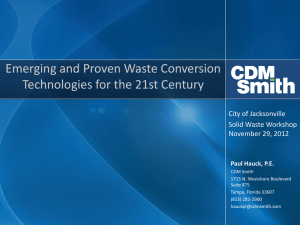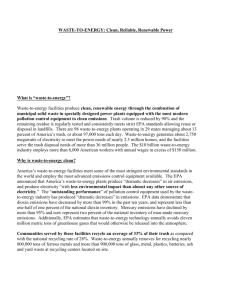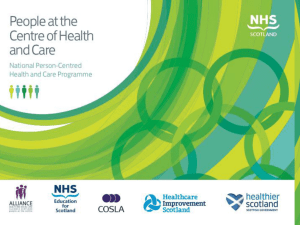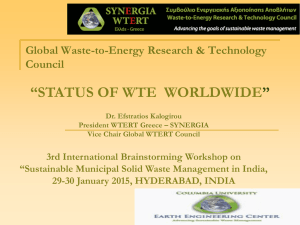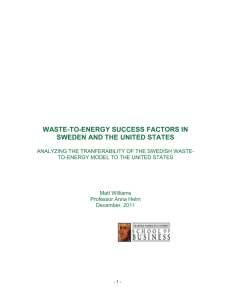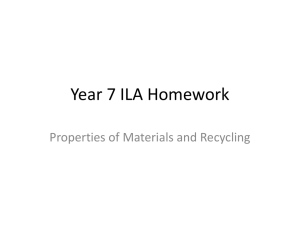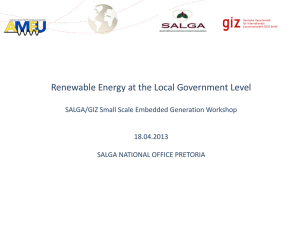Waste-to-Energy in Europe
advertisement
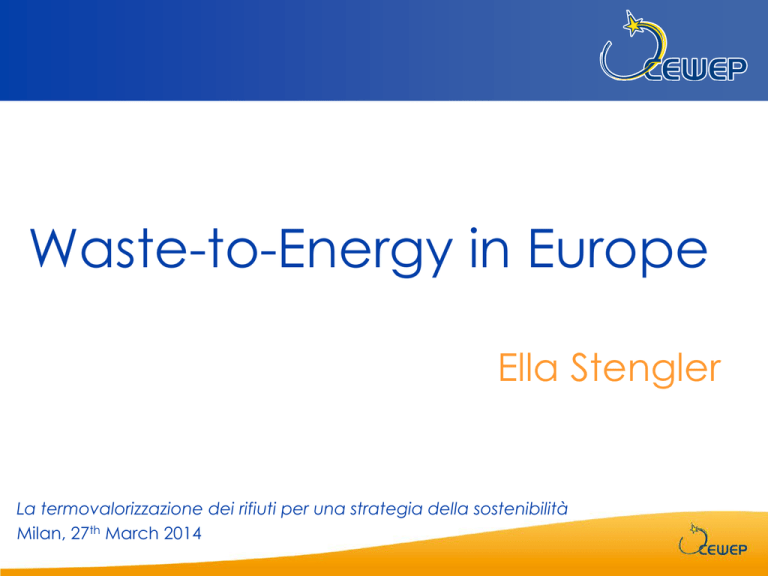
Waste-to-Energy in Europe Ella Stengler La termovalorizzazione dei rifiuti per una strategia della sostenibilità Milan, 27th March 2014 CEWEP Confederation of European Waste-to-Energy Plants CEWEP is the umbrella association of the owners and operators of Waste-to-Energy Plants across Europe. They thermally treat household and similar waste that remains after waste prevention, reuse and recycling by generating energy from it. This is how they replace fossil fuels, such as coal, gas and oil, used by conventional power plants. At the same time Waste-to-Energy Plants help to reduce Greenhouse gas emissions by diverting waste from landfills. Waste-to-Energy Creating reliable, cost-effective, local energy from citizens’ waste Alkmaar WtE plant, the Netherlands Waste-to-Energy Plants (in 2011) CEWEP Members : 66 Mio. tonnes (85%); 378 plants Capacity Europe: 78 Mio. Tonnes; 454 plants Past and future paths for WtE in Europe MSW treatment in EU 27 between 2001 and 2011 Landfill Incineration Recycling and composting 100% 90% 28 80% 31 33 35 37 38 39 39 40 40 40 19 19 20 21 22 22 23 70% 60% 16 17 17 18 50% 40% 30% 56 52 50 20% 48 44 43 41 40 39 38 37 2005 2006 2007 2008 2009 2010 2011 10% 0% 2001 2002 2003 Graph by CEWEP. Source: EUROSTAT 2004 MSW treatment in 2012 EU 28 + Switzerland, Norway and Iceland Graph by CEWEP, Source: EUROSTAT 2012 100% 1 13 90% 80% 42 57 70% 45 47 47 50 39 27 34 46 45 38 40 47 20 60% 50% 20 16 34 24 17 33 27 26 27 25 10 62 65 24 20 10 9 20% 42 34 28 10% 0% 18 0 1 1 2 3 3 33 41 44 37 39 51 54 40 42 50 99 16 52 0 1 77 79 79 73 75 35 35 1 0 7 36 52 49 0 0 2 40% 30% 0 13 18 16 16 21 21 57 87 82 84 85 63 65 57 Recycled & composted % 50 50 Incinerated % Landfilled % 0 2 Moving up the Waste Hierarchy The 6 countries which practically eliminated landfilling (AT, BE, DE, DK, NL, SE) have all introduced landfill bans. ► Most effective means to divert waste from landfills = Bans ► WtE & Recycling are complementary to divert waste from landfills With WtE also treating residues from recycling activities Turning the waste not suitable for recycling into local + affordable energy Contributing to energy + resource efficiency Estimation of WtE capacity* development in EU * refers to both WtE and dedicated RDF plants and includes treatment of MSW and commercial waste similar to MSW At the same time: Recycling will constantly grow and landfilling will be reduced 20 18 16 Additional capacity until 2020 93 million tonnes by the end of 2020 14 Total capacity 2012 12 10 79 million tonnes in 2012 8 6 Data gathered in 2013 4 2 0 DE FR UK NL IT SE ES CH DK BE AT FI PL NO PT CZ IE LT RO HU CY EE BG SK LU SI HR GR LV MT Energy projections from WtE 140 Energy [TWh] 196 TWh 120 100 134 TWh 80 Equivalent amount produced by 6-9 nuclear power stations or 25 coal power plants Enough to supply 70 million inhabitants 100 TWh 60 Half of this energy is renewable 40 20 0 2006 2010 Electricity 1 TWh is equal to 1 billion kWh. Includes both renewable and fossil components. 2020 (realistic) Heat 2020 (potential) Where is Waste-to-Energy going to? Developments in Northern Europe (DE, AT, NL, BE, CH), where the market is mature, tend to involve upgrading/ retrofitting of existing WtE facilities. ► Copenhagen: innovative project for the new Amager Bakke plant replacing the old Amagerforbraending plant nearby - where a ski-slope will be placed on the roof. ► Investment in projects to improve energy efficiency and to connect existing WtE plants to district heating networks to supply heat to nearby homes and industry has been undertaken, e.g. at the AEB Amsterdam and TWENCE plants, that received the Global District Energy Climate Award 2013 Where is Waste-to-Energy going to? Projects elsewhere in Europe are focusing on meeting the EU Landfill Directive target of diverting waste from landfills. ► In 2011 Ireland’s first WtE plant came on-line in Meath, and a second plant in Dublin is planned. ► In the UK some 11 plants, currently authorised or in construction, are likely to come into fruition by 2016. In the meantime, the remaining waste is sent as RDF to Northern Europe, in order to avoid the high landfill tax in the country (£80/t from April 2014). ► In 2013 one plant came into operation in Lithuania and another one in Estonia. ► In Poland 6 plants are planned and are due to be constructed by 2020. ► In Southern Europe the impact of the economic slow-down of the last few years can be seen, as a number of WtE projects in the planning stages have been put on hold. Import/Export of MSW Denmark Estonia Import Export 18,000 t (2011) 150,000 t (2012) 82,500 t (2011) Planned about 20,000 t from Ireland and Finland Germany 763,000 t (2012) 52,000 t RDF (2010) 11,000 t mixed MSW (2010) Italy Netherlands 1,000,000 t (2012) – 80% from the UK Norway 80,000 – 100,000 t RDF (2013) – from the UK to the city of Oslo Sweden 800,000 t (2012) – most from Norway, rest from the UK UK + Ireland Source: CEWEP members 1,586,946 t (2013) RDF to NL, DE and DK 2,500 t (2013) - Irish mixed MSW to Estonia SRF to cement plants in Estonia and Latvia Austria from September 2013: ca. 60,000 t from Italy Can’t everything be recycled? New recycled materials depend on the quality of the sorted waste: ► Materials too dirty or too contaminated (e.g. vacuum-cleaning bags) ► Mixed materials (too difficult/expensive to sort) ► Materials degrade after repeated recycling ► Demand necessary for recycled products If high quality recycling is not possible, the waste should be turned into energy, rather than being landfilled. It is worth noting that residues from recycling also often need thermal treatment Even countries with the highest recycling rates in Europe (e.g. Austria, Belgium, Germany and the Netherlands) depend on WtE to treat remaining waste not suitable for recycling. Modern WtE is safe & clean … Stringent regulations strictly controlled Waste-to-Energy Plants are equipped with sophisticated filtering devices to deal with the pollutants that are in the waste and minimise emissions into the atmosphere. “Directive 2000/76/EC on the incineration of waste makes the incineration of waste one of the most stringently regulated and controlled industrial activities.” Answer given by Mr. Potočnik, Environment Commissioner, to a Parliamentary Question on 10th June 2010 Lisbon University's Institute of Preventive Medicine: waste incineration "does not impact on dioxin blood levels of nearby residents" of Waste-to-Energy plants www.sciencedirect.com Health studies UK Committee of Carcinogenity: “any potential risk of cancer due to residency near to municipal solid waste incinerators was exceedingly low, and probably not measurable by the most modern epidemiological techniques” http://www.advisorybodies.doh.gov.uk/Coc/munipwst.htm A recent Spanish study concluded that the Tarragona Waste-to-Energy plant “does not produce additional health risks for the population living nearby.” It presents results from monitoring of the Tarragona (Catalonia, Spain) Waste-to-Energy plant regarding PCDD/Fs levels in soil, vegetation, and air samples collected in the period 2009–2010. The concentrations of PCDD/Fs in the surroundings of the Tarragona plant were monitored over the last 15 years. http://wmr.sagepub.com/content/30/9/908.full.pdf+html For further Health Studies please visit http://www.cewep.eu/information/healthandenvironment/index.html TOPICS in Brussel’s legislative pipeline Energy Recovery R1 status and Climate Correction Factor Achieving energy recovery status for efficient Waste-to-Energy Plants Waste Framework Directive, Art. 3(15): ‘recovery’ means any operation the principal result of which is waste serving a useful purpose by replacing other materials which would otherwise have been used to fulfill a particular function, or waste being prepared to fulfill that function, in the plant or in the wider economy. Annex II sets out a non-exhaustive list of recovery operations Annex II R 1 ‘Use principally as a fuel or other means to generate energy’ This includes incineration facilities dedicated to the processing of municipal solid waste only where their energy efficiency is equal to or above: 0.60 for plants permitted before 1.1.2009 0.65 for plants permitted after 31.12.2008 Impacts of ‘R1 energy recovery status’ Waste hierarchy: ► Efficient WtE plants are higher up the hierarchy than landfilling. ► Level playing field with co-incinerating industry (e.g. cement kilns) which was already considered as ‘energy recovery’ (European Court of Justice). Public acceptance – building awareness of energy recovery from waste through the improvement of energy efficiency Climate Impacts A warm climate influences the R1 performance of a WtE plant in two ways: 1 2 it decreases electricity production efficiency it limits the heat demand Statistical evidence of R1 value dependency on local conditions was provided by the 3rd CEWEP Energy Efficiency Report CEWEP Energy Efficiency Report III (2012) European WtE plants that reach R1 (0.6) based on geographical area Northern 97% Central 59% South-Western 49% Percentages are calculated based on the total number of plants Climate Impacts Waste Framework Directive, Article 38 “Interpretation and adaptation to technical progress” states: 1. “[...] If necessary, the application of the formula for incineration facilities referred to in Annex II, R1, shall be specified. Local climatic conditions may be taken into account, such as the severity of the cold and the need for heating insofar as they influence the amounts of energy that can technically be used or produced in the form of electricity, heating, cooling or processing steam. [...]” Climate Impacts -2012 Climate Factor Study To address this issue in more details the JRC commissioned a study to Clerens Consulting Investigate the impact of climate on the production and use of energy and assess the opportunity to introduce a climate correction factor Climate Impacts Heating Degree Days (HDD) HDDs > 3350 - cold climate, well developed District Heating network 2150 < HDDs < 3350 - moderate climate, heating demand limited both in quantity and time HDDs < 2150 - warm climate, low heating demand Proposals for a Climate Correction Factor Electricity and Heat Two-stage: B and then A Electricity only A B C Climate Correction Factor Options CEWEP Impact Assessment To assess the impact, four options have been applied to the Southern and Central EU WtE plants that have delivered data for CEWEP Energy Efficiency Report III. Additional number of plants achieving R1 in EU 61 36 4 Option A CCFmax 1.05 Option B CCFmax 1.38 11 CCFmax 1.12 CCFmax 1.66 Data refer to year 2010 and operational years 2007-2010 for the R1 calculations. CEWEP’s opinion on a Climate Correction Factor (CCF) The correlation Climate between CCF influences the and HDD is a R1 value of a useful WtE Plant approach to determine Uneven playing which regions should benefit field in EU from the CCF Considering that landfill diversion is of utmost importance, waste should be used as a resource, moving higher up the hierarchy (i.e. from landfills to R1 WtE plants) The factor should compensate for lower electricity produced but also for lack of heat demand. Nevertheless, it should be appropriate and fair, avoid the impression of a “free ride” and provide incentive to improve efficiency Review of Waste Management Law Review of Waste Management Law Issues covered: ► Review of waste targets ► Ex-post evaluation of EU Directives on separate waste streams ► Assessment of best plastic waste management Review of Waste Management Law The European Commission (COM) is currently working on a communication on “circular economy” which is supposed to be launched in May 2014, including: ► New waste targets (step by step approach 2025 – 2030) ► Phasing out of landfilling of municipal and similar waste ► Recycling for Municipal Waste: from 50% (aim for 2020) to 60, 65 or 70% by 2025/2030? To be discussed: definition and monitoring of recycling, better data/transparency Revision of BREFs (Best Available Techniques REFerence) documents Best Available Techniques REFerence documents (BREFs) revision timeframe Work programme for the EIPPC Bureau, Seville: ► Start 2013: review of BREF Waste Treatment (inter alia flue gas cleaning residues, stabilisation processes); estimated final draft 2015 ► Start 2014: review of the BREF Waste Incineration Bottom ash will be covered in BREF WI; estimated final draft 2016 To conclude: CEWEP members stay for ► High environmental standards ► Waste-to-Energy’s contribution to Europe’s • Circular Economy (inan integrated approach) and • Resource and Energy Efficiency ► Diverting waste from landfills with the help of both, quality recycling and efficient Waste-to-Energy, providing local, cost-effective and secure energy! For more information on Waste-to-Energy CEWEP Confederation of European Waste-to-Energy Plants Boulevard Clovis 12A, B-1000 Brussels Tel. +32 2 770 63 11 Fax +32 2 770 68 14 ella.stengler@cewep.eu www.cewep.eu
